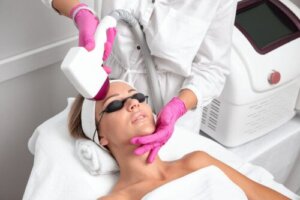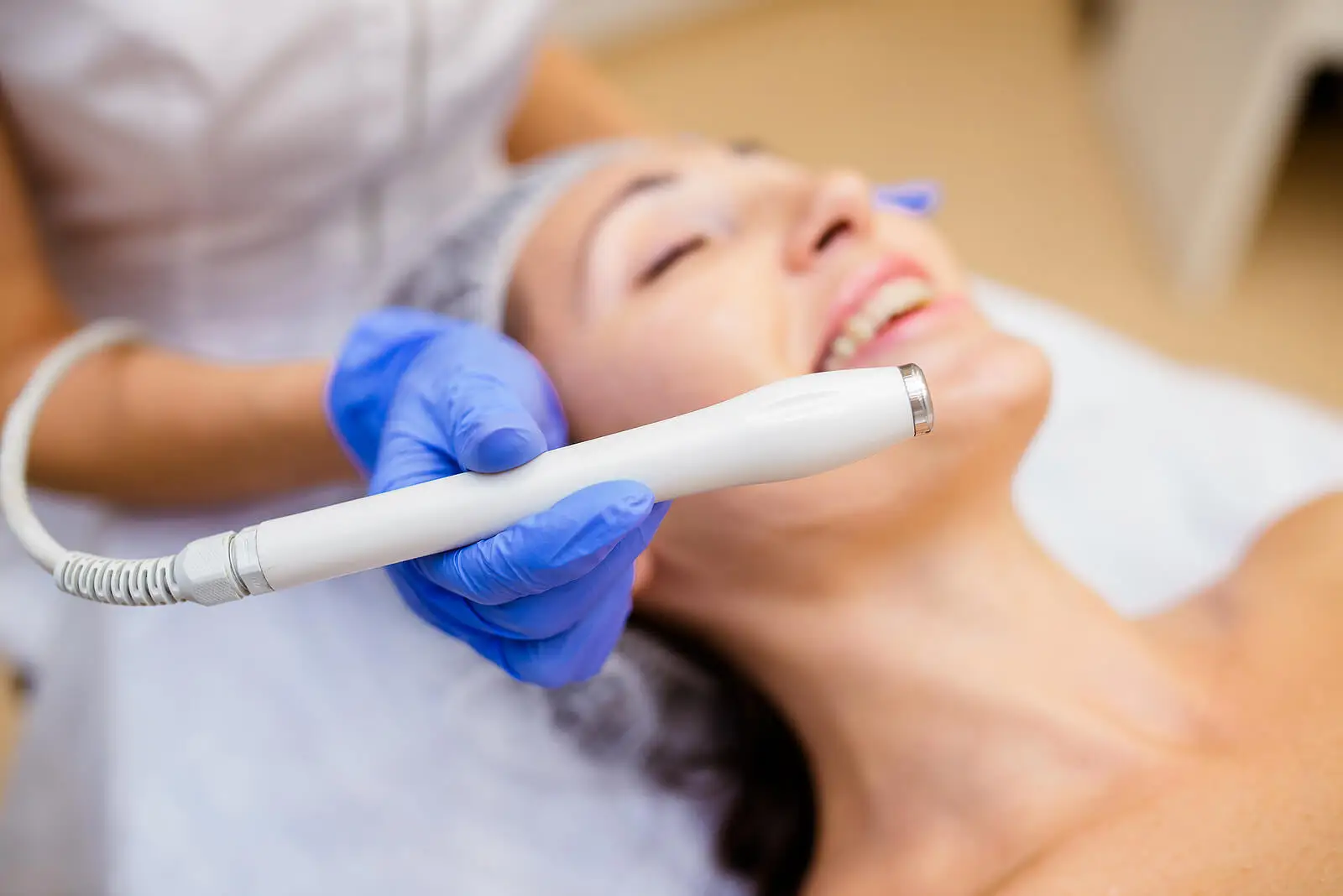The Advantages of CO2 Laser for Periocular Aging


Reviewed and approved by the nurse Leidy Mora Molina
CO2 laser is a treatment that serves as an alternative to conventional blepharoplasty. The latter is surgery performed to remove excess skin from the eyelids or to repair them in cases of abnormality.
The truth is that the eyelids are one of the areas most affected by the passage of time. Their skin is very thin and is composed of internal structures that undergo changes with age. Fortunately, through this intervention, it’s possible to minimize this periocular aging.
Its main advantage over blepharoplasty is that it significantly reduces the effects and postoperative complications. At the same time, it offers very good aesthetic results. In this article, we’ll talk about this procedure.
What is CO2 laser for periocular aging?
CO2 laser is a blepharoplasty – eyelid surgery – which is performed with a laser scalpel. It’s a technique in which excess eyelid tissue is vaporized in a selective and controlled manner.
It’s a “point to point” procedure. This means that each area of the eyelid can be vaporized differently, depending on the amount of excess skin, thickness, etcetera. With each shot of the CO2 laser, a very specific retraction of the skin is produced.
In addition, it’s less dependent on the surgeon’s skill. It can rearrange the shape of the eye and its contour in a very precise way. Each incision is very clean, fine, and accurate, which then manifests itself in better results.

Benefits and advantages of CO2 laser
The CO2 laser has great advantages over conventional eyelid surgery. The most important is that it leaves no scarring and reduces bleeding to a minimum. Only a thin scab is formed, which requires minimal care during the postoperative period.
The procedure is ambulatory and only requires the application of local anesthesia. Similarly, the postoperative period is quick and undemanding, with less swelling, bruising, and ecchymosis. It also offers optimal results, such as the following:
- Noticeable reduction of fine wrinkles, especially those known as “crow’s feet“.
- It causes a tightening effect without the need to resort to other procedures.
- The eyelid skin is revitalized and looks more luminous.
- It eliminates spots and redness around the eyes, which unifies the skin tone.
Procedure
Often, local anesthesia, usually a cream, is applied to perform the CO2 laser technique. The procedure is performed in the doctor’s clinic, or in a health center. If the bags under the eyes are very noticeable, a conventional blepharoplasty may be necessary.
Usually, only one session is necessary. Sometimes a little more is required, but this is rare. The procedure takes between 30 and 70 minutes, depending on the complexity of the case and whether it’s performed on the lower eyelid only or both.
The steps are as follows:
- The areas of the skin to be dried out are marked.
- Then, protective contact lenses are placed in the eye.
- Next, local anesthesia is applied. In some cases, it isn’t necessary.
- Subsequently, the excess skin is removed using the CO2 laser, with the “point to point” technique, as explained above.
- The fat is removed with minimal laser incision, which doesn’t require sutures.
- Finally, the wound is closed with a very fine suture.
You might also be interested in: Ptosis or Droopy Eyelid: Causes and Treatments
Tips and recommendations
After the CO2 laser procedure, it’s quite normal for some repairing and soothing substances to be applied to the area to reduce discomfort. There’s usually no pain, although there may be some tingling and a feeling of dryness.
There’s almost always only mild swelling and perhaps minor bruising for the first few days. This can be managed with the application of cold and usually disappears on the third or fourth day after the intervention.
The patient can perform daily activities from the first day, but it’s recommended to avoid social activity and smoky environments for at least a week. Also, tasks that require a lot of effort aren’t recommended. There should be no direct sun exposure for a month after the procedure.
Some additional recommendations are as follows:
- Shower with lukewarm water, not hot.
- Sleep with your head raised for two days after the CO2 laser.
- Sleep in a horizontal position, face up, for the first three days.
- Wear sunglasses for the first month.
- Don’t wear makeup until the stitches are removed. Mascara should only be used up to three weeks after the procedure.
- Use artificial tear drops if you feel dryness in the eye.
- Use sunscreen on the area for at least two months.

Read more here: 6 Natural Methods to Reduce Under Eye Bags
Final recommendations
The final results of CO2 laser blepharoplasty are usually noticeable from the second or third week after the procedure. After this, it’s possible to notice a rejuvenated appearance.
However, it’s very important that this procedure is performed by a certified professional. In addition, it’s advisable to program it for times of the year when there’s less sun, such as autumn or winter. This way, there are fewer risks during recovery.
All cited sources were thoroughly reviewed by our team to ensure their quality, reliability, currency, and validity. The bibliography of this article was considered reliable and of academic or scientific accuracy.
- Yumeen S, Khan T. Laser Carbon Dioxide Resurfacing. [Updated 2021 Nov 18]. In: StatPearls [Internet]. Treasure Island (FL): StatPearls Publishing; 2022 Jan-. Available from: https://www.ncbi.nlm.nih.gov/books/NBK560544/
- Wilder-Smith, P., Arrastia, A. M. A., Liaw, L. H., & Berns, M. (1995). Incision properties and thermal effects of three CO2 lasers in soft tissue. Oral Surgery, Oral Medicine, Oral Pathology, Oral Radiology, and Endodontology, 79(6), 685-691.
- Agramonte Centelles, I., Rodríguez Salinas, G., Hernández Sánchez, Y., & Dorrego Oduardo, M. D. (2013). Cirugía de blefaroplastia por técnica convencional versus láser de CO2. Revista Cubana de Oftalmología, 26(3), 390-398.
- Alster TS, Bellew SG. Improvement of dermatochalasis and periorbital rhytides with a high-energy pulsed CO2 laser: a retrospective study. Dermatol Surg. 2004 Apr;30(4 Pt 1):483-7; discussion 487. doi: 10.1111/j.1524-4725.2004.30160.x. PMID: 15056134.
This text is provided for informational purposes only and does not replace consultation with a professional. If in doubt, consult your specialist.








